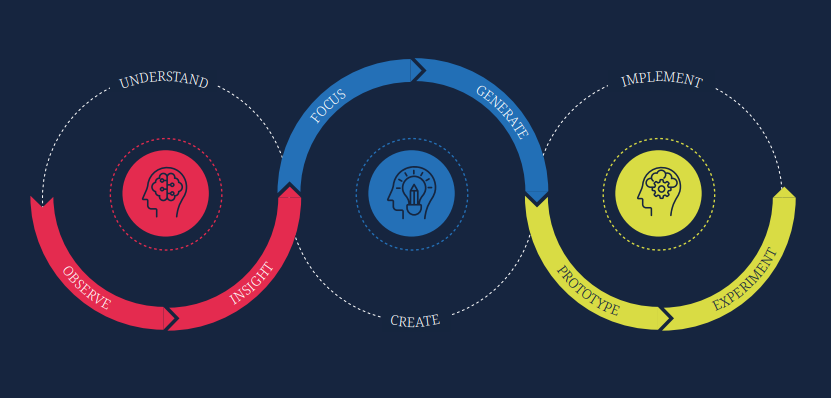
Shift your mindset, see problems in a new light, and get better outcomes
Do you want to interact with your business in a different way? Or find more innovative solutions to business problems? Issues can range from encouraging collaboration between teams, to how to get the best output from your supply chain. Often, when we look at a problem, people focus on the surface level and only get a surface-level solution. The solution works, but not as well as it could.
About DLA Design
The DLA Design Framework


Benefits of design thinking
-
Helps you uncover the challenges and needs in your business.
-
Tackles existing challenges with fresh eyes and a new approach.
-
Encourages questions that go to the heart of challenges and motivations.
-
Provides the tools to broaden thinking around solutions, with a fail-fast approach through experimenting and prototyping.
Application of Design Thinking
There are various ways we can apply DLA Design in-person or virtually:
- Design Workshops: An interactive workshop bringing people together to brainstorm and dig deeper into a specific challenge.
- Away Day: DLA Piper will host an away day, allowing teams to come together in a creative environment. You and your team will challenge underlying assumptions, explore the problem, and suspend judgement to create solutions.
- Design Sprint: Design sprints are about identifying the solution to your business challenge. Using the DLA Design methodology, we then help you to create solutions, making sure you're at the center of the building process.
- Capability Building: We can deliver training to build design thinking capability in your team and organization. We cover the fundamental phases of the design-thinking framework, share practical applications you can apply day-to-day, and teach you how to reframe the way you approach problems and create solutions.
Case study
When drafting contracts, a global toy production company previously had to consult multiple guidance documents. It was complicated and time consuming for the legal team, and their internal stakeholders felt the turnaround times were too slow.
We ran a DLA Design session with members of the global toy production company to understand why the process was so complicated, what their pain points were, and brainstorm what a solution would look like.
The result was Sidebar: an add-in for Microsoft Word that displays all guidance the legal team needs to create a draft contract. Guidance can be turned off when the contract is sent to a third party – and back on again when it’s returned.
Sidebar means the business can create contracts quickly and seamlessly, and by being hosted on their own system it removes the need to search multiple guidance documents.
Get in touch with our team to learn more about DLA Design.
We partnered with Cancer Research UK’s legal team to help them create a new annual strategy. The charity’s legal team is mostly remote and found it hard to get together with enough time and space to solve challenges or generate ideas.
At a DLA Design away day, the team reflected on its current strategy and identified areas of priority. A key challenge for the legal team emerged. How do they support the overall mission statement of Cancer Research UK: “further, faster, together we will beat cancer”?
With our DLA Design methodology, we asked attendees to break this tagline down. To consider how the legal function supports each mission word individually.
In the workshop, the legal team identified the need to make their value proposition to the organisation clearer. They have the ability to help grow the business while also protecting the commercial interests.
The away day ended with plans to increase the legal team's visibility and impact in the organization. They resolved to join cross-departmental meetings and start 'legal surgery' sessions for quick, targeted discussions, thereby raising their profile and better aligning with Cancer Research UK's broader objectives.
“What was brilliant about your design thinking methodology was that you bubbled to the surface some ideas which were previously just primordial soup. You united the team around them, and we now have a road map for where we want to be and how we get there. All in the space of a few hours! And we had fun while doing it. Hats off to you.” – Gillian Fairfield, Director of Legal Research and Innovation at Cancer Research UK.
A client in the energy industry was facing the challenge of not only shifting to renewable energy sources, but also changing the behaviours and mindset of its employees.
The client wanted its workforce to be more curious, to create and explore new ideas, and to challenge its traditional ways of working. Both its legal and marketing teams were tasked with achieving this change. But they didn’t know quite where to start.
So we introduced them to DLA Design, our design thinking methodology. We created a day-long workshop for 12 people from the two teams. The purpose was twofold: to help them get to the root of the challenge of the change project, and to train them as design thinking facilitators. To support that, we coached them in the following months as they set about tackling and leading on their change projects using design thinking techniques.
The result was a core team of people with the confidence and skills to introduce design thinking across their organisation, facilitate design thinking sessions across multiple business areas, and drive forward change across their organisation
Get in touch to learn more about how DLA Design can support your business.
In partnership with HKA, a leading global risk mitigation and dispute resolution consultancy firm, our team ran a roundtable on gender balance in construction. The participants included senior stakeholders from construction companies across the Middle East. They took away two main solution areas to develop.
The first key takeaway was the importance of empowering women already in leadership positions to enable other women to progress. The second key takeaway was the importance of inspiring the next generation of women in construction in the early stages of their education. With two key solutions identified, we wanted to continue the conversation, and facilitated a design thinking session on the idea of empowering women in leadership to be advocates for other women in achieving gender balance.
“Approaching gender balance through design-thinking methodology brought a structure to the roundtable that was critical to ensure we ultimately drive change.” – Suzannah Newboult, partner and global board member, DLA Piper.
The design thinking session set out tangible next steps, allowing the initiative to be carried forward through the new gender balance in construction committee. This committee has pledged to meet quarterly, to check in on agreed actions, and share results, successes and best practice.
Through individual and collective pledges, the team identified numerous actions. These included creating a healthy environment where people aren't afraid to speak up, reading literature from different cultures, transparency around promotions, mentorship programs, and social media campaigns sharing success stories.
We partnered with a leading global bank to introduce and integrate their newly developed Intellectual Property (IP) framework. The bank's objective was clear: demonstrate to the wider business how the legal team can be a catalyst for innovation and creativity, rather than a hindrance.
Using DLA Design, our design thinking methodology, we hosted an event with the global bank’s IP team that allowed them to think creatively and challenge their current processes.
Before the event, our DLA Design team assessed how the legal team had previously launched new process guidance and how successful that was. We wanted to understand how the business interacted with the legal team and where the pain points were.
In the workshop, we facilitated discussions around our assessment. We dug deep into how the IP team either incentivises or blocks the behaviours they want the bank to adopt, and how they want the business to engage with the framework in the long term.
By questioning the existing process, the legal team ended the day with a new launch strategy. They would promote their services digitally on their online innovation hub, and designate ambassadors across different business services lines to be a champion and point of contact for the IP team. These ambassadors would also participate in senior leadership forums to boost awareness of the legal team.
A major retail and commercial bank wanted to empower its legal team to live the bank’s value of curiosity in their daily work. To be more curious in their approach to challenges.
Using our DLA Design methodology, we created a bespoke workshop for the bank. It explored how to unleash curiosity throughout the day, and uncovered what was holding the legal team back from experimenting or idea sharing – and how to overcome those barriers.
We split the bank’s legal team into two groups and assigned them current priorities for the bank. One group focused on drafting contracts, and the other sustainability.
The contracts group started to challenge their current contract drafting process. They asked themselves: why do we do it this way? What is the process really trying to achieve? And what are the pain points?
By questioning their current process, the contracts group worked out how to increase the speed of contract drafting and mitigate risk. We then developed this solution further with the legal team in a design thinking sprint.
The sustainability group reflected on the bank’s sustainability achievements and looked ahead at their goals for engaging in the bank’s wider sustainability targets. They found ways they could contribute and hold themselves accountable, and left with development plans to further educate and upskill the team. They also uncovered ways to get inspired to continue the ideation within sustainability.
The bank’s legal team left the DLA Design workshop with tangible actions and goals to bring their values to life.
Is it right for me?
Design thinking is suitable for everyone and every organization, particularly those who want to:
- be more creative
- solve a problem a different way
- learn new skills, tools and techniques needed for innovation
- bring their team together by doing something fun and different to create change
